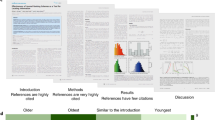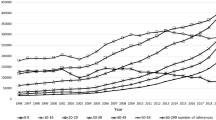Abstract
To compare citation history and contextual “importance”, eleven highly cited articles, 4 slowly aging (Type 1) and 7 quickly aging (Type 2), were ranked using an aggregate citation context measure, the Mean Utility Index. Based on citations in late (PY 6 & 7) source articles, “methods” papers consistently ranked higher than papers cited for research results and theoretical implications, and Type 1 methods papers ranked above all Type 2 papers. A Type 1 paper representing an important theoretical concept could not be distinguished from Type 2 papers using citation context alone.
Similar content being viewed by others
Notes and references
J. ZIMAN,Public Knowledge: The Social Dimension of Science, NY, Cambridge University Press, 1968.
K. SUBRAMANYAM,Scientific and Technical Resources, NY, Marcel Dekker, 1981.
H. G. SMALL, Citation context analysis. In: B. J. DERVIN, M. J. VOIGHT (Eds)Progress in Communication Sciences, Norwood, NJ, ABLEX, Vol. 3, 1982, pp. 287–310.
B. CRONINThe Citation Process, London, England, Taylor Graham, 1984.
J. R. RAVETZ,Scientific Knowledge and its Social Problems, Oxford, England, Clarendon Press, 1971.
W. O. HAGSTROM,The Scientific Community, NY, Basic Books, 1965.
G. N. GILBERT, Referencing as persuasion,Social Studies of Science, 7 (1977) 113.
M. WEINSTOCK, Citation indexes, In:Encyclopedia of Library and Information Science, NY, Marcel Dekker, Vol. 5, 1971, pp. 16–40.
H. G. SMALL, B. C. GRIFFITH. The structure of scientific literatures I: Identifying and graphing specialties,Science Studies, 4 (1974) 17.
E. GARFIELD, M. V. MALIN, H. SMALL, Citation data as science indicators, In: ELKANA et al. (Eds)Toward a Metric of Science: The Advent of Science Indicators, NY, John Wiley & Sons, 1978, pp. 179–207.
L. SMITH, Citation analysis,Library Trends, 23 (1981) 83.
M. LINE, Obsolescence and changes in the use of literature with time,Journal of Documentation, 30 (1974) 283.
J. VLACHY, Citation histories of scientific publications. The data sources,Scientometrics 7 (1985) 505.
E. R. STINSON, F. W. LANCASTER, Synchronous versus diachronous methods in the measurement of obsolescence by citation studies,Journal of Information Science, 13 (1987) 65.
K. W. McCAIN, The Communication of Research-Related Information in Genetics, paper presented at the annual meeting of the Society for The Social Studies of Science, Worcester, MA. 21 Nov 1987.
H. DOLMAN, H. BODEWITZ, Sedimentation of a scientific concept: The use of citation data,Social Studies of Science, 15 (1985) 507.
A. P. W. HODDER, C. BALOG, A citation study of significant papers in plate tectonics,Journal of Information Science, 9 (1985) 221.
A. FEIDLER, C. D. HURT, Stratospheric aerosols: The transfer of scientific information,Library and Information Science Research, 8 (1986) 243.
D. A. De STEPHANO, citation analysis and adaptive radiation,Scientometrics, 11 (1987) 43.
S. COLE, The growth of scientific knowledge: Theories of deviance as a case study, In:The Idea of Social Structure: Papers in Honor of Robert K. Merton, NY, Harcourt, Brace, Jovanovich, 1975, pp. 175–220.
I. RUFF, Citation analysis of a scientific career: A case study,Social Studies of Science, 9 (1979) 81.
In his “Current Comments” essays,GARFIELD has occasionally examined the citation profiles of seminal papers written by Nobel laureates or theirouevres. See, for example,Essays of an Information Scientist, 4 (1981) 609; 6 (1983) 413; 8 (1986) 416, 432.
E. S. AVERSA,Citation Patterns of 400 Scientific Papers and their Relationship to Literature Aging, Unpublished dissertation, Philadelphia, Drexel University. 1984.
E. S. AVERSA, Citation patterns of highly cited papers and their relationship to literature aging: A study of the working literature,Scientometrics, 7 (1985) 383.
T. A. BROOKS, Private acts and public objects: An investigation of citer motives,Journal of the American Society for Information Science, 36 (1985) 223.
A useful introduction to this and other genetic engineering techniques can be found in: R. W. OLD, S. B. PRIMROSE,Principles of Gene Manipulation: An Introduction to Genetic Engineering, CA, University of California Press, 1981.
These types of errors have been the subject of citation analyses in their own right. See, for example, R. N. BROADUS, An investigation of the validity of bibliographic citations,Journal of the American Society for Information Science, 34 (1983) 132., and S. E. COZZENS, Split citation identity: A case study from economics,Journal of the American Society for Information Science, 33 (1982) 233.
B. C. PERITZ, A Classification of citation roles for the social sciences and related fields,Scientometrics, 5 (1983) 303.
M. J. MORAVCSIK, P. MURUGESAN, Some results on the function and quality of citations,Social Studies of Science, 5 (1975) 86. This was the first of a series of anlyses, in the physics literature.
D. E. CHUBIN, S. D. MOITRA, Content analysis of references: Adjunct or alternative to citation counting?Social Studies of Science, 5 (1975) 423.
C. OPPENHEIM, S. P. RENN, Highly cited old papers and the reasons why they continue to be cited,Journal of the-American Society for Information Science, 29 (1978) 225.
I. SPIEGEL-ROSING, I. SCHWIDETSKY, Comparative bibliometric profiles of physical anthropology and human genetics,Homo 27 (1976) 31; I. SPIEGEL-ROSING, Science studies: Bibliometric and content analysis,Social Studies of Science, 7 (1977) 97.
T. HODGES,Citation Indexing: Its Potential for Bibliographic Control. Unpublished dissertation, University of California, Berkeley, 1978.
See, for example, the AIBS Style Manual, frequently cited in “instructions to authors” sections in Biology journals. CBE Style Manual Committee,Council of Biology Editors Style Manual: A Guide to Authors, Editors, and Publishers in the Biological Sciences, 4th. ed., American Institute of Biological Sciences, Arlington, VA, 1978.
R. A. DAY,How to Write and Publish a Scientific Paper, Philadelphia PA: ISI Press, 1979.
A. J. MEADOWS, The scientific paper as an archaeological artefact,Journal of Information Science, 11 (1987) 27.
H. VOOS, K. S. DAGAEV, Are all citations equal? or Did weOp. Cit. yourIdem?Journal of Academic Librarianship, 1 (1976) 19.
S. J. K. BERTRAM,The Relationship between Intra-document Citation Location and Citation Level, Unpublished dissertation, IL, University of Illinois, 1970.
B. FINNEY,The Reference Characteristics of Scientific Texts. Unpublished dissertation, City University of London, Centre for Information Science, 1979. Cited in Ref. 8. M. WEINSTOCK, Citation indexes, In:Encyclopedia of Library and Information Science, NY, Marcel Dekker, Vol. 5, 1971, pp. 16–40.
G. HERLACH, Can retrieval of information from citation indexes be simplified?Journal of the American Society for Information Science, 29 (1978) 308.
S. BONZI, Characteristics of a literature as predictors of relatedness between cited and citing works,Journal of the American Society for Information Science, 33 (1982) 208.
For information on index numbers, see entries on Index Numbers pp. 495–498; Statistical Techniques in Economics and Business, an Overview, pp. 886–893, In:Encyclopedia of Economics, NY: McGraw-Hill, 1982.
Please note that there is no intended relationship between our use of “utility” and the economist's concept of utility. For a discussion of the latter concept, see the entry on Utility pp. 934–941, in:Encyclopedia of Economics, NY, McGraw-Hill, 1982.
M. KOCHEN, Models of scientific output, In: Y. ELKANA et al. (Eds),Toward a Metric of Science: The Advant of Science Indicators. NY, John Wiley & Sons, 1978, pp. 97–136. See p. 127.
H. G. SMALL, Cited documents as concept symbols,Social Studies of Science, 8 (1978) 327.
H. SMALL, E. GREENLEE, Context analysis of a co-citation cluster: Recombinant-DNA,Scientometrics, 2 (1980) 277.
H. SMALL, The lives of a scientific paper, In: K. S. WARREN (Ed.),Selectivity in Information Systems: Survival of the Fittest, NY, Praeger Scientific, 1985, pp. 83–97.
S. E. COZZENS, Comparing the sciences: citation context analysis of papers from neuropharmacology and the sociology of science,Social Studies of Science, 15 (1985) 127.
See Ref. 23, p. 64.
E. GARFIELD, Citation frequency as a measure of research activity and performance,Essays of an Information Scientist, 1 (1977) 406.
B. C. GRIFFITH, H. SMALL, J. STONEHILL, S. DEY, The structure of scientific literature II: The macro- and micro-structure of science,Science Studies, 4 (1974) 339.
E. GARFIELD,Citation Indexing: Its Theory and Application in Science, Technology, and Humanities, NY, John Wiley & Sons, 1979.
E. GARFIELD, The articles most cited in 1961–1982. 2. Another 100Citation Classics highlight the technology of science,Essays of an Information Scientist, 7 (1985) 218.
E. GARFIELD, The articles most cited in 1961–1982. 4. 100 AdditionalCitation Classics, Essays of an Information Scientist, 7 (1985) 306.
E. CARFIELD, The ‘Obliteration Phenomenon’ in science - and the advantage of being obliterated!Essays of an Information Scientist, 2 (1977) 396.
See quote from P. A. SHARP in ref. 55, p. 307.
E. GARFIELD, Uncitedness III — The importance of not being cited,Essays of an Information Scientist, 1 (1977) 413.
D. De SOLLA PRICE, Networks of scientific papers,Science, 149 (1965) 510.
See G. S. STENT, Prematurity and uniqueness in scientific discovery,Scientific American, 227 (1972) 84; H. V. WYATT, Knowledge and prematurity-journey from transformation to DNA,Perspectives in Biology and Medicine, 18 (1961) 596.
S. COLE, Professional standing and the reception of scientific discoveries,American Journal of Sociology, 76 (1970) 286.
E. M. ROGERS,Diffusion of Innovations, 3rd ed., NY, MacMillan, 1983.
See, for example, W. GOFFMAN, Mathematical approach to the spread of scientific ideas —The history of mast cell research,Nature, 205 (1966) 449.
Author information
Authors and Affiliations
Rights and permissions
About this article
Cite this article
McCain, K.W., Turner, K. Citation context analysis and aging patterns of journal articles in molecular genetics. Scientometrics 17, 127–163 (1989). https://doi.org/10.1007/BF02017729
Received:
Issue Date:
DOI: https://doi.org/10.1007/BF02017729




